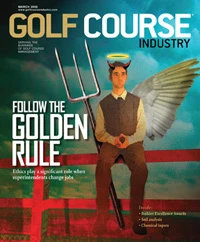Did you ever wonder what the world’s most beautiful woman, diamond or flower looks like? I’m sure many of us have wondered about those things from time to time. However, the problem we face when contemplating whether any one thing might be the best of its class is there are no established absolute world-class standards to measure against. Because all polling is subjective and opinion driven, mankind never has been able to universally designate one thing or that as the very best of its kind. However, there’s an exception to this premise, and it exists in the golf world. First, some history.
Shortly after I became the GCSAA executive director during the fall of 1980, I met with headquarters staff to develop the editorial schedule for the following year’s association magazine (then known as the Golf Course Superintendent). However, because the GCSAA automatically dedicated its annual March issue to the Masters Tournament – and had been doing so for many years – a problem arose quickly: What writing theme should we adopt for the March 1981 issue? A fresh writing angle was and still is difficult to come by year after year.
I suggested we talk to GCSAA members and staff who attended the Masters the previous year or two and ask them for ideas about the subject based on their visits. Silence fell across the room. I didn’t know GCSAA members and staff weren’t granted access to the Masters, and this surprised me. When I looked into the matter further, I found out the Masters granted PGA and CMAA officers and heads of staff total-access season passes for the full week, free grounds access to the top class of each association’s membership, and issued the PGA and CMAA annual $2,500 checks for each association’s scholarship foundations. The GCSAA was extended none of these courtesies at the time.
Consequently, I picked up the phone and called then-Masters chairman, the late Hord Hardin, to talk about the matter. Quickly, Hardin advised me he was completely unaware of the GCSAA circumstance and offered to correct the situation immediately. He did and the GCSAA has enjoyed equal footing with the PGA and CMAA ever since.
Now, I want to encourage as many GCSAA members (class “A” and “A Retired” are granted free admission) as possible to make a determined effort to attend the Masters as early in their professional careers as possible and tell them why. But first some personal observations/recommendations relative to attending the Masters:
1. Make hotel reservations up to a year early because available hotel space is always scarce;
2. Make sure to visit the course maintenance facility to see an unbelievable level of human and equipment organization;
3. The best days to walk the Augusta National course are during the practice sessions (Monday through Wednesday, after which most superintendents then go home) when the final agronomic fine tuning of the golf course is under way; and
4. Wednesday afternoon (when the Par 3 tournament draws the players and gallery elsewhere) the Augusta National golf course literally becomes a living laboratory where you can see the grounds crew applying final grooming touches to the course for the next day’s start of play and hundreds of golf course superintendents walking the golf course (alone or in small groups) taking pictures and notes and asking grounds crew members a wide range of questions.
5. A Masters visit is a submittable, educational employer expense.
Golf course superintendents should attend the Masters Tournament early in their careers because they’ll see a standard of maintenance excellence that’s not available anywhere else – and unless witnessed wouldn’t be believed possible.
Augusta National might be the only place on earth where it’s abundantly clear to all that an absolute world-class standard has been created and is maintained every year.
Once visited, Augusta National will burn a standard of excellence into the minds of every visiting golf course superintendent that will drive his or her career forever. Granted, no golf course superintendent will ever have the Masters’ budget or be able to close a course for several months each year to further maintenance practices, but that’s not the point. The point is every GCSAA member who visits Augusta National will be reaching for the “impossible dream” (the Masters dream) forever, never realizing it but becoming a better golf course superintendent for life because of the pursuit. GCI
Jim McLoughlin is the founder of TMG Golf (www.TMGgolfcounsel.com), a golf course development and consulting firm, and is a former executive director of the GCSAA. He can be reached at golfguide@roadrunner.com or 760-804-7339. His previous columns can be found on www.golfcourseindustry.com.

Explore the March 2008 Issue
Check out more from this issue and find your next story to read.
Latest from Golf Course Industry
- From the publisher’s pen: Conscientious of a bigger role
- Bernhard and Company partners with Laguna Golf Phuket
- Terre Blanche showcases environmental stewardship
- VIDEO: Introducing our December issue
- Bernhard and Company introduces Soil Scout
- Nu-Pipe donates to GCSAA Foundation’s Centennial Campaign
- GCSAA enhances golf course BMP tool
- Melrose leadership programs sending 18 to 2026 GCSAA Conference and Trade Show





